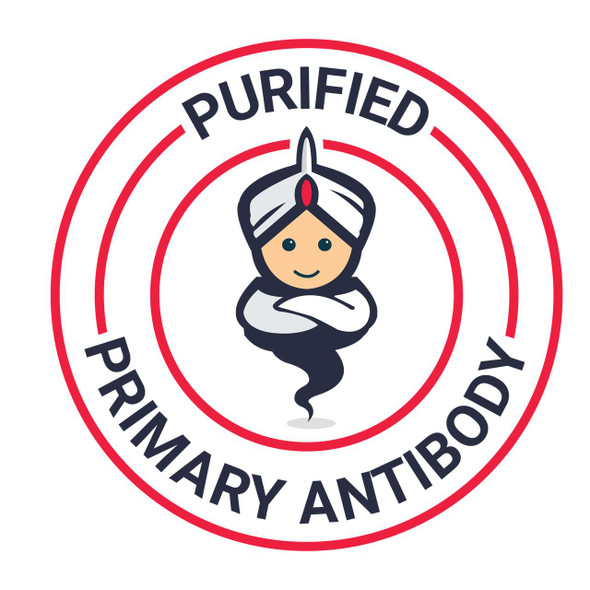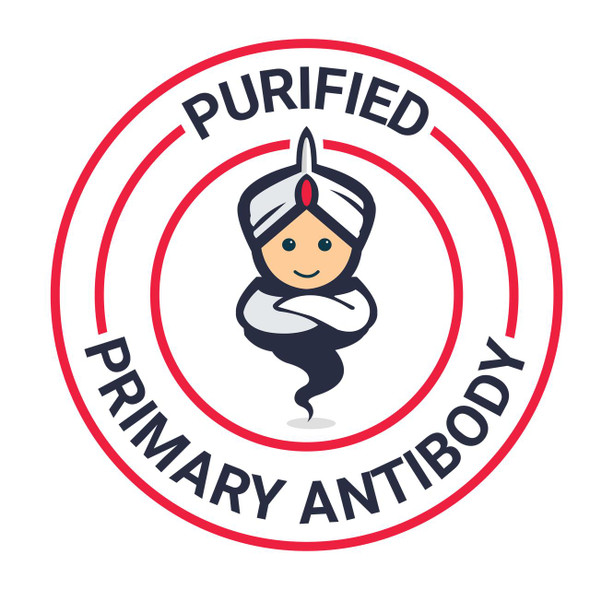Description
| Product Name: | HLA-DR/Dy747 monoclonal antibody (PE/Dy747) |
| Product Code: | AGIM0131 |
| Size: | 500 µL |
| Reactivity: | Human |
| Clone: | MEM-12 |
| Applications: | Flow Cytometry |
| Conjugate: | PE/Dy747 |
| Isotype: | IgG1 kappa |
| Host Species: | Mouse |
| Storage: | Store at 4°C. Avoid prolonged exposure to light. |
| Uniprot: | P01903 |
| Background: | HLA-DR, a member of MHC class II glycoproteins, that bind intracellularly processed peptides and present them to the Th cells, is composed of 36 kDa alpha chain and 27 kDa beta chain, both anchored in the plasma membrane. Togetherwith other MHC II molecules HLA-DR plays a central role in the immune system . |
| UniProt Protein Function: | HLA-DRA: Binds peptides derived from antigens that access the endocytic route of antigen presenting cells (APC) and presents them on the cell surface for recognition by the CD4 T-cells. The peptide binding cleft accommodates peptides of 10-30 residues. The peptides presented by MHC class II molecules are generated mostly by degradation of proteins that access the endocytic route, where they are processed by lysosomal proteases and other hydrolases. Exogenous antigens that have been endocytosed by the APC are thus readily available for presentation via MHC II molecules, and for this reason this antigen presentation pathway is usually referred to as exogenous. As membrane proteins on their way to degradation in lysosomes as part of their normal turn-over are also contained in the endosomal/lysosomal compartments, exogenous antigens must compete with those derived from endogenous components. Autophagy is also a source of endogenous peptides, autophagosomes constitutively fuse with MHC class II loading compartments. In addition to APCs, other cells of the gastrointestinal tract, such as epithelial cells, express MHC class II molecules and CD74 and act as APCs, which is an unusual trait of the GI tract. To produce a MHC class II molecule that presents an antigen, three MHC class II molecules (heterodimers of an alpha and a beta chain) associate with a CD74 trimer in the ER to form a heterononamer. Soon after the entry of this complex into the endosomal/lysosomal system where antigen processing occurs, CD74 undergoes a sequential degradation by various proteases, including CTSS and CTSL, leaving a small fragment termed CLIP (class-II-associated invariant chain peptide). The removal of CLIP is facilitated by HLA-DM via direct binding to the alpha-beta-CLIP complex so that CLIP is released. HLA-DM stabilizes MHC class II molecules until primary high affinity antigenic peptides are bound. The MHC II molecule bound to a peptide is then transported to the cell membrane surface. In B-cells, the interaction between HLA-DM and MHC class II molecules is regulated by HLA-DO. Primary dendritic cells (DCs) also to express HLA-DO. Lysosomal miroenvironment has been implicated in the regulation of antigen loading into MHC II molecules, increased acidification produces increased proteolysis and efficient peptide loading. Belongs to the MHC class II family. |
| UniProt Protein Details: | Protein type:Membrane protein, integral Chromosomal Location of Human Ortholog: 6p21.3 Cellular Component: Golgi membrane; cell surface; lysosome; lysosomal membrane; late endosome membrane; integral to plasma membrane; plasma membrane; trans-Golgi network membrane; MHC class II protein complex Molecular Function:MHC class II receptor activity; peptide antigen binding Biological Process: peptide antigen assembly with MHC class II protein complex; cytokine and chemokine mediated signaling pathway; T cell costimulation; antigen processing and presentation of exogenous peptide antigen via MHC class II; immune response; cognition; T cell receptor signaling pathway; antigen processing and presentation of peptide or polysaccharide antigen via MHC class II; polysaccharide assembly with MHC class II protein complex Disease: Hepatitis B Virus, Susceptibility To |
| NCBI Summary: | HLA-DRA is one of the HLA class II alpha chain paralogues. This class II molecule is a heterodimer consisting of an alpha and a beta chain, both anchored in the membrane. It plays a central role in the immune system by presenting peptides derived from extracellular proteins. Class II molecules are expressed in antigen presenting cells (APC: B lymphocytes, dendritic cells, macrophages). The alpha chain is approximately 33-35 kDa and its gene contains 5 exons. Exon 1 encodes the leader peptide, exons 2 and 3 encode the two extracellular domains, and exon 4 encodes the transmembrane domain and the cytoplasmic tail. DRA does not have polymorphisms in the peptide binding part and acts as the sole alpha chain for DRB1, DRB3, DRB4 and DRB5. [provided by RefSeq, Jul 2008] |
| UniProt Code: | P01903 |
| NCBI GenInfo Identifier: | 122206 |
| NCBI Gene ID: | 3122 |
| NCBI Accession: | P01903.1 |
| UniProt Related Accession: | P01903 |
| Molecular Weight: | |
| NCBI Full Name: | HLA class II histocompatibility antigen, DR alpha chain |
| NCBI Synonym Full Names: | major histocompatibility complex, class II, DR alpha |
| NCBI Official Symbol: | HLA-DRA |
| NCBI Official Synonym Symbols: | HLA-DRA1 |
| NCBI Protein Information: | HLA class II histocompatibility antigen, DR alpha chain |
| UniProt Protein Name: | HLA class II histocompatibility antigen, DR alpha chain |
| UniProt Synonym Protein Names: | MHC class II antigen DRA |
| Protein Family: | Draxin |
| UniProt Gene Name: | HLA-DRA |
| UniProt Entry Name: | DRA_HUMAN |








